| Gummy stem blight and black spot: Didymella bryoniae |
Symptom:
- Leaf - water-soaked lesion, inter veinal necrotic scorch
- Lesions - surrounded by a yellow halo, & when spots dry up, they often crack
- Stems - water-soaked lesions and later appear tan
- Stem lesions often cause gummy, reddish -brown or black beads to exud
Black rot
- Affected area - brownish and water soaked
- Advanced stages - rind becomes black and deeply wrinkled
- Large irregular areas of the fruit become bronzed with distinct concentric rings
|
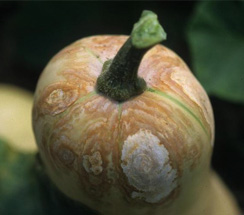 |
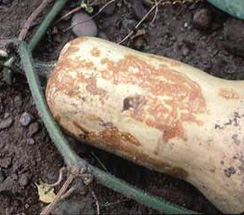 |
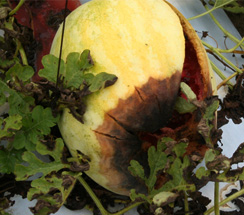 |
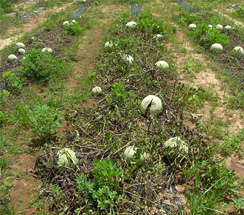 |
| Black rot of squash |
Gummy stem blight on squash |
Black rot of water melon |
Watermelon gummy stem blight |
|
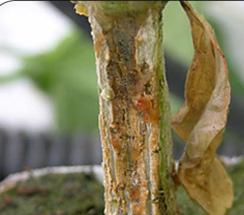 |
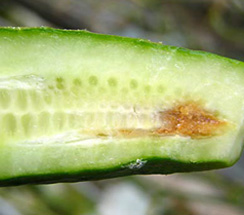 |
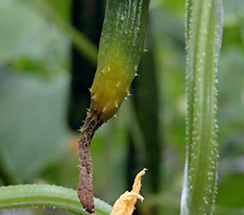 |
| Brownish gummy exuds from stem on cucurbits |
Internal discolouration and rotting of cucurbits |
Severe infection of cucurbit black rot |
|
Identification of pathogen:
- Pycnidia are produced, giving rise to conidia, which serve as the primary inoculum
- Young pycnidia appear light brown & as they age become black
- Conidia - short and cylindrical, with usually one septum near the middle, or they may be unicellular
Mode of spread and survival:
- Soil and seed borne
- Survives as dormant mycelium or as chlamydospores
- Under moist conditions, they are readily dispersed by splashing water
Epidemiology:
- 85%RH
- Optimal temperature - Watermelon 23.9°C , Muskmelon 39°C
|
Management:
- Disease-free seed
- 2-year crop rotation out of all cucurbits
- Field sanitation
- Fungicides - chlorothalanil, mancozeb and benomyl
- Cucumbers - precooled to 10oc or lower temp
|
Source of Images:
http://content.ces.ncsu.edu/gummy-stem-blight-and-phoma-blight-on-cucurbits/
http://www.plantmanagementnetwork.org/elements/view.aspx?ID=6130
http://vegetablemdonline.ppath.cornell.edu/PhotoPages/Cucurbit/Gummy/GSBfs4.htm
www.omafra.gov.on.ca/english/crops/facts/09-051w.pdf |







